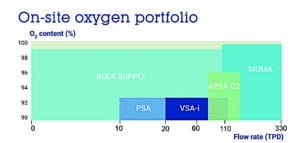Air Liquide is continuing to develop its oxygen technology to make mining easier and smoother for its customers.
Having been in the business since 1902, Air Liquide knows a thing or two about how the mining sector can benefit from oxygen.
The company is constantly redefining and developing its technologies to help ensure the Australian mining industry can continue to produce the quantity and quality of ore for which it is so widely known.
One of these technologies is Pressure Swing Absorption, or PSA, which can produce oxygen on-site.
“We have ridden the waves of PSA development for over 30 years,” national and key account manager – mining and extraction Rick Edwards told Australian Mining.
“The last decade saw a strong shift towards bulk liquid supply, but the tide is beginning to turn and PSAs are again being favoured by the industry.
“This is flagshipped by Air Liquide recently commissioning our first PSA in Western Australia in more than 10 years.”
PSA technology is a leading form of on-site oxygen production for medium to high oxygen consumers operating in the 10–30tpd (tonnes of O2 per day) range. It has always been a popular supply mode for gold mine applications due to their remote proximity and the typical oxygen consumption profiles.
Edwards called the installation a significant milestone for Air Liquide.
“We have revolutionised the PSA solution with a number of key design aspects to significantly increase the reliability and safety of the plant,” he said.
“The plant was designed by local experts and assembled in our WA facility in Henderson.
“The unique design has drawn many eyes from within Air Liquide’s global network and the success of the commissioning signals a revival of the supply mode. We now have a proven solution we can offer with confidence to existing and new customers.”
PSAs have long been the traditional go-to oxygen supply application for most mine sites.
However, the first generation of PSAs had been steadily wearing down due to the usually hot climate of the Australian mine.
“These issues were compounded by an increase in bulk liquid availability and bulk delivery efficiencies,” Edwards said.
“With the low capital cost for the customer and ample supply pressure, the bulk solution became more reliable and cost-effective.
“These changes prompted Air Liquide to revisit PSA technology, but we did so with a revitalised approach.
“The primary objective was to develop a standardised plant that is capable of delivering the typical supply pressure required by our customers while avoiding an oxygen booster, something we are proud to say we have successfully achieved.”

Air Liquide can also offer over-the-fence (OTF) or build-own-operate (BOO) packages to suit a customer’s needs.
“With these packages, Air Liquide takes everything in hand, including installation, operation and maintenance, telemonitored performance tracking and full back-up,” Edwards said.
“An OTF or BOO model is the only way to encase a full oxygen supply solution with guaranteed performance. A supply agreement between both parties ensures the plant meets the agreed flow rate, pressure, purity and ongoing availability.
“Any shortfall in purity or flow rate or any unplanned downtime is addressed by the supplier’s liquid back-up system with no impact to the customer, so the incentive is on us to ensure a reliable system.”
While the revolutionised PSA solution provides an answer to the medium oxygen consumer, Air Liquide is also revolutionising solutions for large consumers, and this is evident with the introduction of its new-generation APSA technology
“The APSA O2 is the latest in low-carbon technology, capable of delivering large volumes of oxygen with high energy efficiency,” Edwards said.
“The APSA uses cryogenic distillation to deliver a higher purity at a reduced energy consumption. It brings the benefits of cryogenic distillation to a market segment that has previously had no alternative to multiple VSAs (vacuum swing adsorption). This is very exciting, as we can now offer the most efficient solution available on the market to high gaseous oxygen consumers.”
This feature appeared in the September 2023 issue of Australian Mining.




